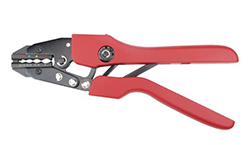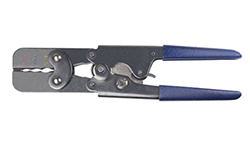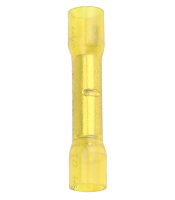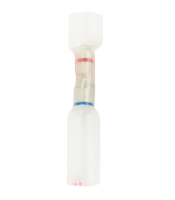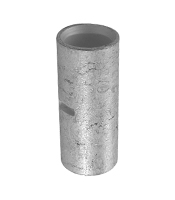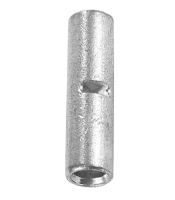Categories
- Wire & Cable
- Multi-conductor & Signal Cable
- Battery Cable Assemblies
- Terminals and Connectors
- Electrical Parts
- Electrical Tools
- ID Products
- Wire Management
- Tape & Sealant
- Mounting Panels & Panel Blanks

Need Help?
Click HereGet a Business Account
Apply HereButt Splices
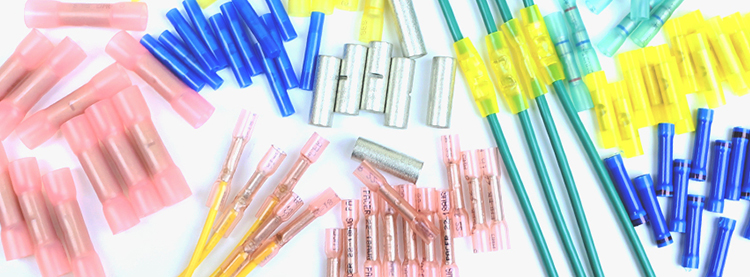
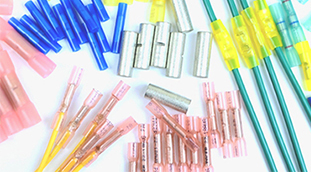
What are butt splices?
Butt splices are a type of crimp connector used to securely join one or more wires together. The specific application depends on the type of butt splice being used. For instance, step-down butt splices are designed to connect a larger gauge wire to a smaller one or to join multiple smaller gauge wires to a single wire. Crimp connectors, including butt splices, ensure reliable and durable electrical connections, making them a common component in various electrical systems due to their ease of use and affordability.
When selecting a type of butt splice, it’s essential to determine whether it needs to be epoxy-lined. Many manufacturers do not include a meltable adhesive inside the splice, which is crucial for creating an environmentally sealed connection. This epoxy reacts to heat, expanding to form a secure seal that protects against moisture and other hazards. This makes it especially useful for marine and high-exposure environments. Epoxy-lined butt splices are only available with heat shrink insulation. Other options include vinyl, nylon, and non-insulated varieties, which are better suited for environments where environmental sealing is not a primary concern. Pacer offers a wide selection of butt splices, including heat shrink, nylon, vinyl, and non-insulated types, each offering unique advantages.
Where are butt splices used?
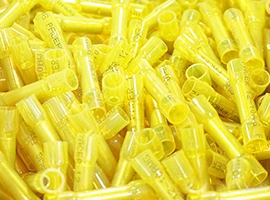
Butt Splices offer advantages over other terminals
Butt splices are commonly used to connect multiple wires to complete an electrical circuit. They are ideal for new wiring installations and equally useful for repairs and maintenance. Signs that a butt splice need to be replaced include cracking, discoloration, or loosening. All you will need are the proper tools. Ensuring a secure and durable connection is crucial for maintaining system integrity and preventing electrical hazards. Now let us take a look at what makes these types of connectors advantageous.
Advantages of Butt Splices
Butt splices provide several benefits, such as: Protecting the connection from impact and abrasion, offering longevity and durability, and in the case of epoxy-lined heat shrink, providing resistance to moisture, chemicals, and stress. These features make butt splices a preferred choice for various applications, including marine, automotive, and industrial electrical systems.
![]()
Impact Resistance
![]()
Abrasion Resistance
![]()
Moisture Resistance
![]()
Chemical Resistance
![]()
Stress
Relief
How to Use a Butt Splice?
First, make sure you have correctly stripped the wires to the proper length. Inside of the butt splice, you will see an indentation your wires should butt up against. Be careful to make sure that the butt splice and the wire insulation are touching. Otherwise, you run the risk of damaging the wire due to exposure. The stripped wire is inserted into one side of the butt splice and crimped with the proper tool. This crimp bends the connector around the wire creating a solid connection. Next, you simply repeat the process on the other side.
- Choose the appropriate size and type of butt splice for your task.
- Strip the wire ends so that the exposed conductors reach the indentation inside the splice barrel, with the insulation of the wire or cable touching the outer edge of the insulation.
- Insert one wire end into the splice and crimp it with the correct tool.
- Perform a tug test by gently pulling the wire and splice apart to ensure a secure connection.
- Repeat the process at the opposite end of the butt splice.
- If using an epoxy-lined heat shrink butt splice, apply heat to activate the adhesive and create a sealed connection.

What types of Insulation are available for butt splices?
Butt splices are available in a range of insulation types so that you can find the exact style you need. Ideal for use with marine wire, Pacer offers non-insulated butt splices, nylon butt splices, vinyl butt splices, and heat shrink butt splices. It is important to note that when dealing with marine applications you should only use marine grade butt splices. Otherwise, you leave your electrical connections vulnerable to the harsh marine environment. All Pacer butt splices are marine grade making them ideal for a range of applications. Let’s look at the differences between the various insulation types.

Non-Insulated: The most economical option, often used in sealed enclosures or protected environments.
Nylon: Offers good protection with translucent insulation, allowing for easy crimp inspection.
Vinyl: Suitable for environments where moisture and contaminants are not a concern but still offers decent protection.
Heat Shrink: Provides the highest level of protection, creating an environmental seal that blocks out moisture, dust, and contaminants.
For marine applications, only marine-grade butt splices should be used to prevent corrosion and ensure long-term reliability.
Does the insulation on my butt splice matter?
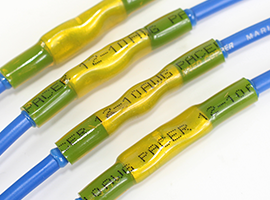
Yes, insulation plays a critical role in determining the protection level of the connection. Heat shrink splices offer the most security, making them ideal for high-moisture environments.
Nylon, vinyl, and non-insulated splices are suitable for less demanding conditions but should be chosen carefully based on environmental factors.
Tools for crimping butt splices
Butt splices are designed to be crimped with specific tools. Wire connectors and other crimp connectors always need the proper tools. Determining the correct tool can be as easy as looking at the wire gauge. However, this is not always the case. The most versatile tool for butt splices is out VTTR50. This tool can pretty much handle every butt splice we carry as well as fork terminals, rings, disconnects, and more. Another versatile tool that will work on a multitude of terminals is our VT3120CT. Additionally, we carry a range of crimpers that can work with a variety of butt splices as well as other terminals.
What types of butt splices are available?
Butt splices are not a one-size-fits-all type of terminal, and as such, we carry a range of styles and types. Let’s take a quick look at some of the more common types of connectors that we carry. Remember, one of the most important aspects of selecting the correct type is selecting an insulation that offers the protection you want. To learn more about the various types of insulation, click here.
Heat shrink Heat shrink butt splices offer the highest level of protection possible. That is due to the epoxy lining that we mentioned earlier. This lining creates an environmental seal that locks out moisture and helps to prevent corrosion. Heat shrink butt splices also offer stress relief on the wire itself and will arguably last the longest when considering other types of insulation. This is what makes these the most effective type of butt splices that you will find. They can literally handle nearly any environment.
Step-down Step down butt splices are designed with a different internal diameter on each side of the connector body. This is so you can connect a larger size wire to a smaller wire. You can even connect multiple wires together. So, you could connect two wires to two even smaller wires. A good example would be the TBSD14-18. This terminal is designed for a 14 AWG wire on one side and an 18 AWG wire on the other. You could, however, put two 16 AWG wires on one side and two 20 AWG wires on the other. This is what makes these butt splices so useful.
Seamless barrel Seamless barrel butt splices are essentially the same as the heat shrink butt splices just without the heat shrink. They offer a high degree of protection and can be installed in seconds. Seamless barrel butt splices get their name from the fact that they have no seam. This means that they can keep out dust and other particulates. One useful aspect of seamless barrel butt splices is that they are available in nylon insulation, vinyl insulation, or non-insulated. Our seamless barrel butt splices are available in 22-18 AWG, 16-14 AWG, and 12-10 AWG.
Seamless tinned Seamless tinned butt splices are extremely similar to the seamless barrel butt splices that we mentioned above. The biggest difference between these connectors is the wire sizes that they work with. Whereas a seamless barrel butt splice works with 22 AWG – 10 AWG wires, a seamless tinned butt splice will work with 8 AWG to 4/0 AWG. We offer them in 8 AWG, 6 AWG, 4 AWG, 2 AWG, 1/0 AWG, 2/0 AWG, and 4/0 AWG. Another important difference is that these connectors are only available in non-insulated.
How are butt splices different from other connectors?
Unlike other electrical connectors such as ring terminals or disconnects, butt splices create a permanent connection. This makes them ideal for applications requiring maximum durability and where disconnection is not necessary. Additionally, butt splices can be installed in the middle of a wire, allowing for repairs or modifications without altering the entire system.

Why choose Pacer?
With over 40 years of experience, Pacer is a trusted leader in the industry, supplying high-quality electrical components to boat manufacturers, automotive industries, and more. Our focus on quality and customer service ensures that we provide reliable solutions tailored to various applications.
*This page was updated on 5/1/2025*



